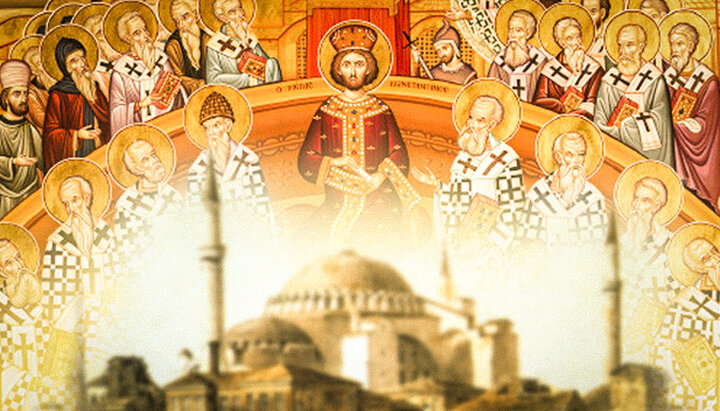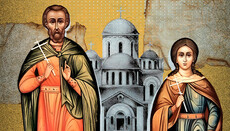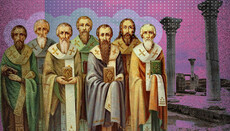Of the origin of the Constantinople Patriarchate

In this material, we will try to figure out whether there are real historical prerequisites for recognizing the exclusive role of the Patriarchate of Constantinople.
The opening line of "The Tale of Bygone Years" (“The Primary Chronicle”) by the Monk Nestor the Chronicler: "of the origin of the Russian land ..." opens a historical narrative about where Rus’ came from. By analogy with this, it is interesting to find out the origin of the Patriarchate of Constantinople and the reasons that led it to its current position in the Orthodox world. After all, if we carefully read the New Testament, and especially the book of the Acts of the Apostles, which describes the Church in its primordial original structure, then we will not find there any weighty grounds for not only the existence of the Patriarchate of Constantinople but also patriarchates as such, as well as metropolitanates, exarchates, autonomies and autocephalies, in a word, the entire administrative structure of the Church that we see now. How, under the influence of what factors, did the Church achieve its modern structure? Is the existence of precisely five patriarchates so unshakable as the Phanar claims? And what allowed Constantinople in the past to occupy a dominant position in the Orthodox world? Understanding all this will be both interesting and useful from a practical point of view.
Organization of the Church in the first two hundred years
The Church of Christ was born on the day of Pentecost when the Holy Spirit descended on the apostles. And the beginning of its spread throughout the world is described in the last chapter of the Gospel of Mark: “He said to them, ‘Go into all the world and preach the gospel to all creation. Whoever believes and is baptized will be saved, but whoever does not believe will be condemned. <...> After the Lord Jesus had spoken to them, he was taken up into heaven and he sat at the right hand of God. Then the disciples went out and preached everywhere, and the Lord worked with them and confirmed his word by the signs that accompanied it” (Mk 16: 15-20).
The Apostles of Christ, both from among 12 and from among 70, went to cities and villages, preached the Word of God and founded Christian communities. These communities, at their very foundation, acquired a very specific organizational form, with their own internal hierarchy and division of responsibilities. The apostles of Christ appointed bishops (who were the so-called presbyters/elders) and deacons in the communities they founded. For example, the Book of Acts tells us about the Apostle Paul and his companions: “They preached the gospel in that city and won a large number of disciples. Then they returned to Lystra, Iconium and Antioch, strengthening the disciples and encouraging them to remain true to the faith. ‘We must go through many hardships to enter the kingdom of God,’ they said. Paul and Barnabas appointed elders[a] for them in each church and, with prayer and fasting, committed them to the Lord, in whom they had put their trust.” (Acts 14: 21-23). Elders here obviously mean bishops.
Three ranks of clergy that still exist today were ordained in each particular community in the first centuries of Christianity, and their powers were limited to that community.
It turns out that those three ranks of clergy that still exist today were ordained in each particular community in the first centuries of Christianity, and their powers were limited to that community. They performed divine services, took care of morality, allocated material goods, administered judgment, but apparently did not engage in teaching, or at least it was not obligatory for them. The bishops did not engage in missionary work and did not preach Christ either in other cities and towns or, most likely, in their own city. This was done by other people who, in the books of the New Testament and in other early Christian monuments, were called apostles, prophets, and teachers.
The Apostle Paul writes to the Corinthians: “And God appointed others in the Church, firstly, Apostles, secondly, prophets, thirdly, teachers ...” (1 Corinthians 12:28). Here, by the apostles, it is understood not the apostles from twelve and seventy (or rather not only them), but a quite definite and understandable for the people of that time ecclesiastical position, which existed, like the positions of prophets and teachers (didaskaloi) until the end of the 2nd century. All three of these positions were charismatic when the Holy Spirit commanded them to go to preach the gospel. The book of Acts describes how this was done in practice: “Now in the church at Antioch there were prophets and teachers: Barnabas, Simeon called Niger, Lucius of Cyrene, Manaen (who had been brought up with Herod the tetrarch) and Saul" (Acts 13: 1,2).
The apostles were exclusively itinerant preachers, and they preached only the very foundations of Christianity, founded a community and immediately moved on. The Didache or the Teachings through the 12 Apostles (late 1st century – early 2nd century) says: “Let every apostle who cometh unto you be received as the Lord. He will remain one day, and if it be necessary, a second." This requirement applies to cases when the apostle entered an already existing Christian community. At the same time, the Didache demands that when leaving the apostle take only the food necessary for the further journey and warns that if the apostle asks for money, he is a false apostle.
Prophets are already more solid missionaries in the sense that they preached in already established communities, could stay there for a longer time, and sometimes forever, taught believers not only the basics of Christianity but also explained the teaching to them in more detail and performed divine services. They received from the community a good monetary and material allowance, but at the same time, they did not perform any administrative functions.
The ministry of the apostles, prophets and teachers led by the Holy Spirit united the entire Church. The communities that they founded in different cities and countries adopted the same teaching, received the same direction of development.
Teachers or didaskaloi did almost the same as the prophets, but their ministry based on their own decision to become a teacher was less charismatic, and the teaching itself was taught by them rather in the form of intellectual knowledge rather than charismatic revelation.
Apostles, prophets, and didaskaloi enjoyed greater respect and authority in the Church than bishops. This is evidenced by early Christian monuments. For example, the Didache, urging believers to respect bishops, equates them with prophets and didaskaloi, which suggests that the latter enjoyed indisputable authority, and the bishops had to be called for respect. “Do not show disdain for the bishops, they should be honored by you along with the prophets and didaskaloi; for they do for you the ministry of prophets and didaskaloi." It also contains an indication that the functions of the prophets, didaskaloi, and the apostles over time began to be transferred to the bishops. These three charismatic ministries disappear in the Church on the threshold of the third century.
The ministry of the apostles, prophets and didaskaloi, led by the Holy Spirit, united the entire Church. The communities that they founded in different cities and countries adopted the same teaching, received the same direction of development. These communities professed the same faith though at that time there were still neither canons of the New Testament books nor written rules for the life of the Church, nor clear doctrinal formulations. The activities of these servants of God also made the conciliar form of resolving church issues and disagreements that arose between different communities superfluous.
The rise of metropolitanates and patriarchates
The number of bishops in anсient times was very large; practically every Christian community had its own bishop. The text of the document of the II-III centuries known in science as Сanones ecclesiastici (not to be confused with the Apostolic Canons) suggests that a community consisting of only 12 believers can elect a bishop for itself and even provides for a mechanism for electing a bishop in communities with fewer than 12 Christians.
There were many bishops, their powers did not go beyond the community, and they all were equal. However, as the activities of the apostles, prophets and didaskaloi gradually came to naught, a need arose for such a form of church government as Councils. At the same time, the missionary function is transferred to the bishops of Christian communities. It manifests itself mainly in the fact that the bishops of cities begin to establish Christian communities in nearby villages, at the head of which they place presbyters (already in our modern understanding of this position) or deacons.
The bishops’ powers did not go beyond the community, and they all were equal. However, as the activities of the apostles, prophets and didascaloi gradually came to naught, a need arose for such a form of church government as Councils.
Often such communities, especially in larger villages, are also headed by bishops who are subordinate to the bishop of the city. Such bishops were called chorebishops. And if at the beginning of the emergence of this institution, chorebishops were equal or almost equal to bishops, then over time their powers were narrowed and redistributed in favor of the city bishop on whom they depended.
As Christian communities multiply in the countryside, so does the number of chorebishops. For example, St. Gregory the Theologian in his writings indicates that there were 50 chorebishops in the St. Basil the Great episcopal district. They naturally constituted a council under the bishop in dealing with important matters. The reduction of the powers of the chorebishops eventually equated them with the presbyters/elders; and by the end of the 4th century, this institution disappeared altogether.
In addition, such episcopal districts located nearby begin to gravitate towards each other over time, already forming a metropolitan district headed by the "first bishop" or metropolitan. The term "metropolitan" itself was first encountered in the canons of the First Ecumenical Council (325), but this institution itself appeared at the end of the 2nd century – the beginning of the 3d century.
Canon 34 of the Holy Apostles reads: “The bishops of every nation must acknowledge him who is first among them and account him as their head and do nothing of consequence without his consent; but each may do those things only which concern his own parish, and the country places which belong to it. But neither let him (who is the first) do anything without the consent of all; for so there will be unanimity, and God will be glorified through the Lord in the Holy Spirit." Here we see that with the equality of all bishops in the rite and teaching, a certain subordination already appears in the implementation of the administrative function.
Naturally, large and civilly important cities of the Roman Empire: Rome, Alexandria, Antioch, etc. became the centers of the metropolitan districts. As a rule, Christian communities in these cities were founded by 12 apostles, and this fact gave them even greater authority.
Naturally, large and civilly important cities of the Roman Empire: Rome, Alexandria, Antioch, etc. became the centers of the metropolitan districts. As a rule, Christian communities in these cities were founded by 12 apostles, and this fact gave them even greater authority. As Christianity in these cities grew stronger and the number of believers multiplied, it spread to nearby, less significant cities, where Christian communities treated the community of the main city of their province as their "Mother Church." Today this term, thanks to the claims of Patriarch Bartholomew to supremacy, has been discredited, but still.
The bishops of such minor cities viewed the bishops of the metropolitanates as their elder and more authoritative brothers. From the end of the II century – the beginning of the III century, a conciliar form of governing the Church appears, since that time local Councils, which mainly consist of bishops of one metropolitan district, have been regularly convened. This, for obvious reasons, further elevates the bishop of the metropolitanate. He has more opportunities to notify all bishops about the convocation of the Council, in a larger and more comfortable city it is more convenient to receive and accommodate guests. There, as a rule, there are temples or other premises that can house a large number of participants. Finally, it is more convenient for the bishop of a large city to inform people about the decisions of the Council and to implement them.
It should also be added that in large cities there was more active economic activity, which resulted in more significant financial opportunities for communities in these cities. Education and science flourished, giving the communities more educated clergy and parishioners.
The foundation of a Christian community by the 12 apostles did not make such a community a metropolitanate afterwards. For example, the apostles founded communities in cities such as Troas, Lystra and others, but they never had any advantages. Jerusalem, which is called "the See of Jesus Christ himself" in some writings, was subordinate to the Bishop of Caesarea of Palestine in the II-III centuries. The most important decisive factor in the elevation of a city to the rank of metropolitanate was its political and administrative significance, and not the antiquity of the see, apostolic origin, or other purely religious reasons.
The processes of centralization that were characteristic of the Church in the II-III centuries and led to the emergence of metropolitanates later resulted in the emergence of patriarchates. In the III century, in each main provincial city of the Roman Empire, in each civil metropolitanate, a church metropolitan see was formed, and since there were a lot of such civil metropolitanates, the number of metropolitans was corresponding.
Gradually, the metropolitans of the most important and major cities begin to rise among them. They eventually acquire the status of patriarchs. Thus, the emergence of patriarchates is a logical continuation of the development of the system of metropolitanates and metropolitan districts. The relationship of the patriarchs to the metropolitans, their functions and powers are the same as the powers of the metropolitans themselves in relation to the bishops subordinate to them, this is the right of judgment, appeal, supervision over the election of bishops and their consecration, the convocation and leadership of councils.
The emergence of the Patriarchate of Constantinople
Of the five patriarchates that arose in the first millennium of Christian history, only three were formed in the natural way described above: the Roman, Alexandrian and Antiochian patriarchates. As for the other two, Jerusalem and Constantinople, their formation was somewhat different. As for the Jerusalem Patriarchate, we can only say that after the destruction of Jerusalem and the formation in its place of the city of Aelia Capitolina with a predominantly pagan population, the Christian community of this city lost its former significance and eventually became subordinate to the Metropolitan of Caesarea of Palestine, and the latter, in turn, to the Patriarch of Antioch. Its elevation to the status of patriarchate occurs after the reign of Emperor Constantine the Great, the Holy Sepulcher was opened, the Honorable Tree of the Cross was found, and Christian churches were built. As for the Patriarchate of Constantinople, its rise goes hand in hand with the establishment of Constantinople as the new capital of the empire.
The first mention of the rights of the patriarchs, who were not yet called that way, is contained in Canon 6 of the I Ecumenical Council (325), it reads: “Let the ancient customs in Egypt, Libya, and Pentapolis prevail: that the Bishop of Alexandria have jurisdiction in all these, sine the like is customary for the Bishop of Rome also. Likewise, in Antioch and the other provinces, let the Churches retain their privileges."
As you can see, not Patriarchate of Constantinople but certain "other provinces", whose bishops had the rights of patriarchs are mentioned. What these provinces are explained in Canon 2 of the II Ecumenical Council (381), which repeats and details Canon 6 of the II Council: “The bishops are not to go beyond their dioceses to churches lying outside of their bounds, nor bring confusion on the churches; but let the Bishop of Alexandria, according to the canons, alone administer the affairs of Egypt; and let the bishops of the East manage the East alone, the privileges of the Church in Antioch, which are mentioned in the canons of Nice, being preserved; and let the bishops of the Asian Diocese administer the Asian affairs only; and the Pontic bishops only Pontic matters; and the Thracian bishops only Thracian affairs."
That is, according to this canon, at the end of the 4th century there were not five, but six patriarchates: Roman, Alexandria, Antioch, Ephesus (Asia), Caesarea in Cappadocia (Pontus) and Heraclius (Thrace).
By this time, Constantinople was already the capital of the empire and the II Ecumenical Council, which was also held in Constantinople, decided to grant the bishop of this city some honorary rights. This is stated in Canon 3 of this Council: "The Bishop of Constantinople, however, shall have the prerogative of honour after the Bishop of Rome; because Constantinople is New Rome.”
The jurisdiction of the Bishop of Constantinople extended only to Constantinople, and administratively (formally) he was subordinate to the Bishop of Heraclius.
Here absolutely nothing is said about the rights of the Bishop of Constantinople because they did not differ in any way from the rights of ordinary bishops subordinate to the metropolitans. If Canon 2 speaks about which provinces are subordinate to the bishops of Alexandria, Antioch, Ephesus, etc. to the bishops (patriarchs), then Canon 3 speaks only of the prerogative of honour of the bishop of Constantinople as the bishop of the city, not of the province. Its jurisdiction extended only to Constantinople, and administratively (formally) it was subordinate to the Bishop of Heraclius. This is very funny, but the situation then was approximately the same as the Phanariotes tried to arrange at the very beginning in the OCU to appease Filaret Denisenko: the honorary patriarch was subordinate to the metropolitan.
But over time, this "honorary patriarchy" of Constantinople becomes a de facto patriarchy and is finally assigned to it legally at the IV Ecumenical Council (451), whose Canon 28 reads as follows: “We ourselves have also decreed and voted the same things about the prerogatives of the very holy Church of this same Constantinople, New Rome. The Fathers in fact have correctly attributed the prerogatives (which belong) to the see of the most ancient Rome because it was the imperial city. And thus moved by the same reasoning, the one hundred and fifty bishops beloved of God have accorded equal prerogatives to the very holy see of New Rome, justly considering that the city that is honoured by the imperial power and the senate and enjoying (within the civil order) the prerogatives equal to those of Rome, the most ancient imperial city, ought to be as elevated as Old Rome in the affairs of the Church, being in the second place after it. Consequently, the metropolitans and they alone of the dioceses of Pontus, Asia and Thrace, as well as the bishops among the barbarians of the aforementioned dioceses, are to be ordained by the previously mentioned very holy see of the very holy Church of Constantinople; that is, each metropolitan of the above-mentioned dioceses is to ordain the bishops of the province along with the fellow bishops of that province as has been provided for in the divine canons. As for the metropolitans of the previously mentioned dioceses, they are to be ordained, as has already been said, by the archbishop of Constantinople, after harmonious elections have taken place according to custom and after the archbishop has been notified.”
As you can see, Canon 28, in contrast to Canon 3 of the II Ecumenical Council, to which it refers, speaks not of the prerogative of honour but of specific patriarchal rights. At the same time, the IV Ecumenical Council lists exactly which provinces are subject to the authority of the Bishop of Constantinople, not allowing him to extend his authority beyond their boundaries. And these provinces, as it is easy to see, are the very three patriarchates that had become history: Ephesus, Caesarea in Cappadocia and Heraclius. That is, these patriarchates, due to the capital status of Constantinople and territorial proximity to it, were abolished and subordinated to the Patriarchate of Constantinople. Incidentally, the legates of the Pope protested against this сanon, and the Pope himself did not recognize it for centuries.
However, such subordination occurred naturally during the 4th-5th centuries and the IV Ecumenical Council only documented it legally. For various reasons, hierarchs from other cities often came to the capital of the empire, and they all were guests of the Bishop of Constantinople. Often, taking advantage of their presence, a Council presided over by the same Bishop of Constantinople was made up of them to resolve various church issues. As the bishop of the reigning city, he could also intercede for other bishops before the emperor and resolve other issues. All this contributed to the fact that it was the Constantinople bishop who enjoyed the actual patriarchal rights rather than the bishops of the above three provinces.
For example, the church historian Theodorite writes about the Constantinople Archbishop John Chrysostom (347-407): "John had care not only about his city but also about the whole of Thrace, even the whole of Asia, and ruled the entire Pontic province." Subsequently, when St. John Chrysostom was removed from the see, this non-canonical at that time interference in the affairs of other Churches would be blamed on him along with other accusations.
Conclusions
The conclusions from this brief historical background can be as follows:
Firstly, the entire administrative system of the Church with patriarchates, metropolitan districts, as well as subsequently emerging exarchates, autonomies, etc. has neither any sacred meaning nor apostolic origin. It arose due to the specific political and other conditions prevailing at that time. At some stage, the Church, with Her conciliar mind, considered that it was precisely such forms of administrative structure that would be the most effective.
Secondly, over time and with changes in historical conditions, these forms have developed and changed. Subsequent Ecumenical Councils already regulated some relations between the Local Churches in a different way than the previous Councils. It follows from this that the Church as a living organism has the right to modify these forms of government in relation to new historical conditions because they, we repeat, do not constitute the subject of the Christian faith. Actually, this is what we observe. For example, a few hundred years ago there was no such thing as an autonomous Church.
Thirdly, the assertion that the Church can exist only and exclusively in the form of five patriarchates (quite popular in the Middle Ages) has no historical or even more dogmatic grounds. As already mentioned, the II Ecumenical Council mentions six patriarchates, among which there is no Constantinople one.
Fourthly, the Church of Constantinople owes its elevation and patriarchal rights solely to the fact that Constantinople was the capital city of the empire. Canon 28 of the IV Ecumenical Council speaks about this very clearly: "because it was the imperial city <...> the city that is honoured by the imperial power and the senate". It follows that if the conditions which this Canon was based on have disappeared, then it itself, at least, loses its meaning.
That is, we can safely say that the current attempts of the Constantinople hierarchs to substantiate their exclusive rights with references to the Ecumenical Councils are not justified either historically or canonically.











